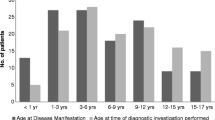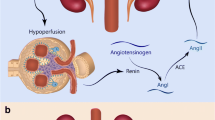Abstract
Neonatal hypertension occurs in 2% of all infants and it is caused by renovascular abnormalities in 70% of these infants. The gold standard for diagnosing renovascular disease is conventional renal angiography. However, in neonates the procedure is not commonly used because of its invasive and technically challenging nature. MRI and MR angiography (MRA) are less invasive yet reliable means of detecting renovascular disease in adults. There is minimal literature on the use of MRI/MRA in neonatal hypertension. We report a neonate with hypertension secondary to a renovascular abnormality in which MRI/MRA was helpful in uncovering segmental renal artery stenosis. The infant underwent partial nephrectomy with subsequent resolution of his hypertension. Further studies are needed to validate the use of MRI/MRA in the evaluation of neonatal hypertension.
Similar content being viewed by others
Explore related subjects
Discover the latest articles, news and stories from top researchers in related subjects.Avoid common mistakes on your manuscript.
Introduction
Recent advances in neonatal medical care have led to an increased awareness of neonatal hypertension. Hypertension has been reported in about 2% of all infants [1]. The etiology of hypertension in this age group is secondary to renovascular abnormalities in 70% of affected infants [2]. In adults, MRI/MR angiography (MRA) has evolved from an experimental tool to the modality of choice for initial noninvasive evaluation of renovascular disease [3, 4]. There is very little mentioned in the literature about the use of MRI/MRA in neonates with hypertension [5, 6]. We describe a neonate in which MRI/MRA was helpful in the diagnosis of segmental renal artery stenosis.
Case report
A 2-day-old boy was transported to our neonatal intensive care unit for evaluation and treatment of severe systemic hypertension. The child was a full-term product of a 39-year-old woman, gravida 2, para 2, with no medical problems. The patient was born by caesarean section and had a birth weight of 3770 g. On day 2 after birth, the patient was noted to be dusky and his blood pressure (BP) was elevated (systolic BP 110–120 mmHg). Laboratory studies showed normal electrolytes, blood urea nitrogen and creatinine. An echocardiogram showed left ventricular dilatation. The patient was started on a nitroprusside drip. He was transferred to the Children's Hospital of Michigan for further management.
On admission, he was afebrile with a heart rate of 129 beats per minute, respiratory rate of 72 per minute and a blood pressure of 115/89 mmHg. Four-limb blood pressures showed no significant difference between the upper and lower extremities. A soft systolic murmur was heard at the lower left sternal border. Good peripheral pulses were noted. The abdomen was soft with no masses or bruit. Renal US showed normal-appearing kidneys without any thrombosis in the renal vessels. A repeat echocardiogram showed normal anatomy with mild mitral insufficiency and a hyperdynamic left ventricle. Plasma renin activity was elevated at 240,400 ng/dl/h (normal range 200–3,500 ng/dl/h). Aldosterone level was also elevated at >120 ng/dl (normal range 1–31 ng/dl). The significantly elevated levels of plasma renin and aldosterone led to suspicion of a renovascular cause. MRI/MRA of the abdomen was then performed on a GE Signa 1.5-T magnet (GE, Milwaukee, Wis.). Procedural sedation was done using midazolam (0.1 mg/kg). Pancuronium (0.1 mg/kg) with intubation and mechanical ventilation were used for breath-holding technique during imaging. Coronal 3-D spoiled gradient recalled acquisition (SPGR) images were obtained (TR 6, TE 1.4, BW 31.2 kHz 1.6, spacing 0.8, matrix 256×128, acquisition 18 s, number of excitation 1 nex) before and after gadolinium administration (0.4 ml/kg). Initially, the results were interpreted as normal-appearing kidneys with no evidence of main renal artery stenosis. The patient was discharged at 2 weeks of age on captopril and proranolol with home monitoring of blood pressure.
An echocardiogram obtained when the child was 2 months old showed a remarkable increase in left ventricular mass. The previous MRI/MRA images were reviewed and, in retrospect, the lower pole of the left kidney showed a slightly irregular contour (Fig. 1). On the dynamic post-gadolinium images, there was decreased perfusion to the lower pole of the left kidney, suggesting the possibility of segmental renal artery stenosis. Subsequently, a conventional renal arteriogram was performed under general anesthesia, and it confirmed the diagnosis of segmental renal artery stenosis (Fig. 2). The infant underwent partial left lower pole nephrectomy with no complications.
The patient's antihypertensive medications were weaned and he was discharged home 1 week later on no medication. Continued follow-up showed that the blood pressure remained within normal limits (80–90/40–50 mmHg). Renal function remained normal. A repeat echocardiogram when the boy was 4 months old showed significant improvement in left ventricular hypertrophy. At the time of writing, the child had no significant medical problems with complete normalization of the echocardiogram.
Discussion
The definition of hypertension in term and preterm neonates has not been standardized. In this age group the blood pressure increases with both gestational and postconceptual age, as well as birth weight [7]. The upper limit for normal blood pressure has been defined as the 95th percentile for age, gender and height [8]. The approach for evaluating neonates with hypertension starts with a focused history, inquiring about any perinatal exposures, current medical conditions and medication as well as procedures undergone such as umbilical artery catheterization. The clinical presentation of hypertension in this age group may vary from incidental isolated elevated blood pressure detection to manifestations of cardiac failure. The initial diagnostic work-up is directed toward identifying secondary causes of hypertension, especially renal and cardiac etiologies. Included in the evaluation are urinalysis, a complete blood count, electrolytes, blood urea nitrogen, creatinine, chest radiograph, renal US and echocardiogram [2, 7].
In our patient, the work-up done for the evaluation of hypertension led us to consider a renovascular cause, which was indicated by his very high plasma renin and aldosterone levels. Although renal US is commonly used in the evaluation of such patients to asses the anatomy, it is not a very reliable test in detecting renovascular causes of hypertension in neonates. Therefore, we elected to perform MRI/MRA as a non-invasive technique to assess the renal vessels looking for a treatable cause of his hypertension.
It is widely accepted that the gold standard for diagnosing renovascular disease is conventional renal arteriography. However, it is an invasive procedure and usually used in older patients. In comparison to conventional arteriogram, MRI/MRA is a less-invasive yet reliable means of detecting renovascular disease in adults, and it is a well-established method for detecting main renal artery disease [3, 4]. According to the National High Blood Pressure Education Program Working Group on High Blood Pressure in Children and Adolescents, MRA is increasingly feasible for evaluation of pediatric renovascular disease; however, there are no neonatal guidelines in the report [8]. There is little literature on the use of MRI/MRA for the evaluation of renovascular disease in neonates. In one report of a neonate with hypertension and proteinuria, MRA detected main renal artery stenosis [5]. In another report, MRI was helpful in detecting a retroperitoneal hematoma causing renovascular hypertension in a 7-week-old infant [6].
In our patient, the rapid dynamic post-gadolinium images showed hypoperfusion of the left lower pole, alluding to segmental renal artery stenosis (Fig. 1). Conventional renal arteriography showed long segment stenosis of the lower pole branch of the left renal artery (Fig. 2). The patient underwent partial nephrectomy of the lower pole of the left kidney with subsequent complete resolution of hypertension one week after surgery. In conclusion, with appropriate anesthetic support, MRI/MRA is a useful and feasible technique in evaluating neonates with severe hypertension. It was helpful in identifying a treatable cause of the neonatal hypertension in our patient. Further prospective studies comparable to those in adults are needed to validate this test in neonatal hypertension. In the future, MRI/MRA might become the test of choice when there is a high index of suspicion for renovascular disease in neonates.
References
Jung FF, Ingelfinger JR (1993) Hypertension in childhood and adolescence. Pediatr Rev 14:169–179
Roth CG, Spottswood SE, Chan JC, et al (2003) Evaluation of the hypertensive infant: a rational approach to diagnosis. Radiol Clin North Am 41:931–944
Leng DA, Hagspiel KD, Angle JF, et al (2002) MR angiography of the renal arteries. Radiol Clin North Am 40:847–865
Marcos HB, Choyke PL (2000) Magnetic resonance angiography of the kidney. Semin Nephrol 20:450–455
Cachat F, Bogaru A, Micheli JL, et al (2004) Severe hypertension and massive proteinuria in a newborn with renal artery stenosis. Pediatr Nephrol 19:544–546
Dixon BP, Devarajan P, Mitsnefes M (2005) Neonatal renovascular hypertension due to prenatal traumatic retroperitoneal hematoma. Pediatr Nephrol 20:670–672
Flynn JT (2000) Neonatal hypertension: diagnosis and management. Pediatr Nephrol 14:332–341
National High Blood Pressure Education Program Working Group on High Blood Pressure in Children and Adolescents (2004) The fourth report on the diagnosis, evaluation, and treatment of high blood pressure in children and adolescents. Pediatrics 114:555–557
Author information
Authors and Affiliations
Corresponding author
Rights and permissions
About this article
Cite this article
Mustafa, A.E., Bloom, D.A., Valentini, R.P. et al. MR angiography in the evaluation of a renovascular cause of neonatal hypertension. Pediatr Radiol 36, 158–161 (2006). https://doi.org/10.1007/s00247-005-0017-x
Received:
Revised:
Accepted:
Published:
Issue Date:
DOI: https://doi.org/10.1007/s00247-005-0017-x






